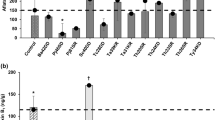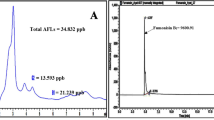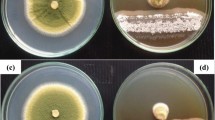Abstract
Fusarium infections result in reduced maize grain (Zea mays L.) yields and notable impacts on human and animal health. Research involving natural products to control fungi in food is a promising alternative. Combinations of α-bisabolol (AB) and sodium chloride (NaCl) may suggest the use of lower effective concentrations of the drugs. This study aimed to evaluate the antifungal potential of AB associated with NaCl against Fusarium oxysporum strains isolated from maize. Minimum inhibitory concentrations (MICs) values of AB and NaCl were determined by microdilution, and an association study was performed (checkerboard). Effects on fungal mycelial growth (poisoned substrate technique) and a maize grain contamination model were analyzed. AB presented MIC values ranging from 128 and 1024 μg/mL; NaCl inhibited fungal growth at 16,384 μg/mL. The AB/NaCl association study revealed synergism by decreasing inhibitory concentrations by eight times. In corn kernels, AB and NaCl, whether isolated (at MIC) or in association (at sub-inhibitory concentrations), significantly inhibited in vitro mycelial growth (P < 0.05). Further analysis of liquid from a canned maize sample also revealed the fungistatic effects of the compounds associations (P < 0.05). The results confirm the antifungal potential of AB, whether isolated or in association with NaCl to control F. oxysporum in maize.
Graphic Abstract




Similar content being viewed by others
References
Augusto De Miranda R, Martinho A, Lício A (2014) Diagnóstico dos Problemas e Potencialidades da Cadeia Produtiva do Milho no Brasil. Embrapa Milho e Sorgo, Sete Lagoas
Correa AAS, Quinzani SSP, Peixoto DV, Silveira Corrêa TC (2016) A tradição do milho: o ingrediente base da cozinha caipira e das festas juninas. Ágora 18:99. https://doi.org/10.17058/agora.v18i1.6917
Lanubile A, Maschietto V, Borrelli VM et al (2017) Molecular basis of resistance to fusarium ear rot in maize. Front Plant Sci 8:1774. https://doi.org/10.3389/fpls.2017.01774
Gordon TR (2017) Fusarium oxysporum and the Fusarium Wilt Syndrome. Annu Rev Phytopathol 55:23–39. https://doi.org/10.1146/annurev-phyto-080615-095919
Qin PW, Xu J, Jiang Y et al (2020) Survey for toxigenic Fusarium species on maize kernels in China. World Mycotoxin J 13:213–224. https://doi.org/10.3920/wmj2019.2516
Hassan ZU, Al Thani R, Balmas V et al (2019) Prevalence of Fusarium fungi and their toxins in marketed feed. Food Control 104:224–230. https://doi.org/10.1016/j.foodcont.2019.04.045
Blesa E, Aliño M, Barat JM et al (2008) Microbiology and physico-chemical changes of dry-cured ham during the post-salting stage as affected by partial replacement of NaCl by other salts. Meat Sci 78:135–142. https://doi.org/10.1016/j.meatsci.2007.07.008
Huang L, Trieu K, Yoshimura S et al (2020) Effect of dose and duration of reduction in dietary sodium on blood pressure levels: systematic review and meta-analysis of randomised trials. BMJ 368:m315. https://doi.org/10.1136/bmj.m315
Harper NM, Getty KJK (2012) Effect of salt reduction on growth of listeria monocytogenes in meat and poultry systems. J Food Sci. https://doi.org/10.1111/j.1750-3841.2012.02975.x
Al-Samarrai G, Singh H, Syarhabil M (2012) Evaluating eco-friendly botanicals (natural plant extracts) as alternatives to synthetic fungicides. Ann Agric Environ Med 19:673–676
Pandey AK, Kumar P, Singh P et al (2017) Essential oils: sources of antimicrobials and food preservatives. Front Microbiol 7:2161. https://doi.org/10.3389/fmicb.2016.02161
Kamatou GPP, Viljoen AM (2010) A review of the application and pharmacological properties of α-bisabolol and α-bisabolol-rich oils. J Am Oil Chem Soc 87:1–7. https://doi.org/10.1007/s11746-009-1483-3
Jahanshiri Z, Shams-Ghahfarokhi M, Asghari-Paskiabi F et al (2017) α-Bisabolol inhibits Aspergillus fumigatus Af239 growth via affecting microsomal ∆24-sterol methyltransferase as a crucial enzyme in ergosterol biosynthesis pathway. World J Microbiol Biotechnol 33:1–8. https://doi.org/10.1007/s11274-017-2214-9
Leslie JF, Summerell BA, Bullock S (2006) The Fusarium Laboratory Manual. Wiley-Blackwell, Ames
Clinical and Laboratory Standard Iinstitute (2017) M38 reference method for broth dilution antifungal susceptibility testing of filamentous fungi, 3rd edn. Clinical and Laboratory Standard Iinstitute, Wayne
Doern CD (2014) When does 2 plus 2 equal 5? A review of antimicrobial synergy testing. J Clin Microbiol 52:4124–4128. https://doi.org/10.1128/JCM.01121-14
Silva KVS, Lima MIO, Cardoso GN et al (2017) Inibitory effects of linalool on fungal pathogenicity of clinical isolates of Microsporum canis and Microsporum gypseum. Mycoses 60:387–393. https://doi.org/10.1111/myc.12606
Dambolena JS, Zunino MP, López AG et al (2010) Essential oils composition of Ocimum basilicum L. and Ocimum gratissimum L. from Kenya and their inhibitory effects on growth and fumonisin production by Fusariumverticillioides. Innov Food Sci Emerg Technol 11:410–414. https://doi.org/10.1016/j.ifset.2009.08.005
Menniti AM, Gregori R, Neri F (2010) Activity of natural compounds on Fusarium verticillioides and fumonisin production in stored maize kernels. Int J Food Microbiol 136:304–309. https://doi.org/10.1016/j.ijfoodmicro.2009.10.008
Coban HB (2020) Organic acids as antimicrobial food agents: applications and microbial productions. Bioprocess Biosyst Eng 43:569–591. https://doi.org/10.1007/s00449-019-02256-w
Ferrigo D, Raiola A, Causin R (2016) Fusarium toxins in cereals: occurrence, legislation, factors promoting the appearance and their management. Molecules 21:627. https://doi.org/10.3390/molecules21050627
Butt UR, Naz R, Nosheen A et al (2019) Changes in pathogenesis-related gene expression in response to bioformulations in the apoplast of maize leaves against Fusarium oxysporum. J Plant Interact 14:61–72. https://doi.org/10.1080/17429145.2018.1550217
Inguglia ES, Zhang Z, Tiwari BK et al (2017) Salt reduction strategies in processed meat products: a review. Trends Food Sci Technol 59:70–78. https://doi.org/10.1016/j.tifs.2016.10.016
Jaenke R, Barzi F, McMahon E et al (2017) Consumer acceptance of reformulated food products: a systematic review and meta-analysis of salt-reduced foods. Crit Rev Food Sci Nutr 57:3357–3372. https://doi.org/10.1080/10408398.2015.1118009
Lucca AJD, Pauli A, Schilcher H et al (2011) Fungicidal and bactericidal properties of bisabolol and dragosantol. J Essent Oil Res 23:47–54. https://doi.org/10.1080/10412905.2011.9700457
Caesar LK, Cech NB (2019) Synergy and antagonism in natural product extracts: when 1 + 1 does not equal 2. Nat Prod Rep 36:869–888. https://doi.org/10.1039/c9np00011a
Oren A (2011) Thermodynamic limits to microbial life at high salt concentrations. Environ Microbiol 13:1908–1923
Raut JS, Karuppayil SM (2014) A status review on the medicinal properties of essential oils. Ind Crops Prod 62:250–264. https://doi.org/10.1016/j.indcrop.2014.05.055
Pauli A (2006) α-Bisabolol from chamomile: a specific ergosterol biosynthesis inhibitor? Int J Aromather 16:21–25. https://doi.org/10.1016/j.ijat.2006.01.002
Oliveira JC, de Vasconcelos PÂ, de Medeiros CAC et al (2020) The sensitivity modifying activity of nerolidol and α-bisabolol against Trichophyton spp. Indian J Microbiol 60:505–510. https://doi.org/10.1007/s12088-020-00895-2
Perricone M, Arace E, Corbo MR et al (2015) Bioactivity of essential oils: a review on their interaction with food components. Front Microbiol. https://doi.org/10.3389/fmicb.2015.00076
Cherrat L, Espina L, Bakkali M et al (2014) Chemical composition and antioxidant properties of Laurus nobilis L. and Myrtus communis L. essential oils from Morocco and evaluation of their antimicrobial activity acting alone or in combined processes for food preservation. J Sci Food Agric 94:1197–1204. https://doi.org/10.1002/jsfa.6397
Danielli LJ, Pippi B, Soares KD et al (2017) Chemosensitization of filamentous fungi to antifungal agents using Nectandra Rol. ex Rottb. species essential oils. Ind Crops Prod 102:7–15. https://doi.org/10.1016/j.indcrop.2017.03.013
Tyagi AK, Gottardi D, Malik A, Guerzoni ME (2014) Chemical composition, in vitro anti-yeast activity and fruit juice preservation potential of lemon grass oil. LWT Food Sci Technol 57:731–737. https://doi.org/10.1016/j.lwt.2014.02.004
Macwan SR, Dabhi BK, Aparnathi KD, Prajapati JB (2016) Essential oils of herbs and spices: their antimicrobial activity and application in preservation of food. Int J Curr Microbiol Appl Sci 5:885–901. https://doi.org/10.20546/ijcmas.2016.505.092
Acknowledgements
The authors would like to thank the Department of Agriculture (Cuité, Brazil) and National Supply Company (Brazil) for supplying the maize grains.
Author information
Authors and Affiliations
Contributions
FOP and IOL conceived and designed the experiments; CACM, AVP, and JCO performed the experiments and analyzed data; CACM and GSS wrote the paper; GSS and JMMA executed the article editing. JMMA contributed to the critical reading of the manuscript and experiments with maize. All authors read and approved the final manuscript.
Corresponding author
Ethics declarations
Conflict of Interest
No conflict of interest declared.
Additional information
Publisher's Note
Springer Nature remains neutral with regard to jurisdictional claims in published maps and institutional affiliations.
Rights and permissions
About this article
Cite this article
de Medeiros, C.A.C., Pinto, Â.V., de Oliveira, J.C. et al. Evaluating the Antifungal Activity of α-Bisabolol in Association with NaCl on Fusarium oxysporum in Maize Grains. Curr Microbiol 78, 604–610 (2021). https://doi.org/10.1007/s00284-020-02313-8
Received:
Accepted:
Published:
Issue Date:
DOI: https://doi.org/10.1007/s00284-020-02313-8




